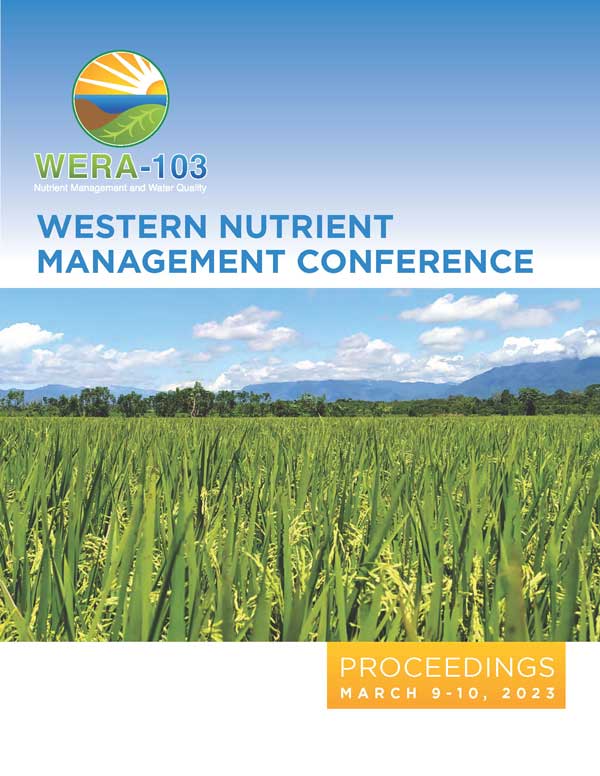Download the Conference Proceedings
Proceedings
Authors
| Filter results7 paper(s) found. |
|---|
1. Influence of Dairy Manure Applications on Corn Nutrient UptakeCorn silage is the predominant crop in Idaho used for recovering phosphorus (P) that has accumulated in soils from dairy manure applications. However, little is known about how much phosphorus and other nutrients are being recovered under Idaho conditions. The objective of the study is to estimate phosphorus removal by irrigated corn silage crops cultivated throughout Southern Idaho with variable soil test P concentrations, and to identify effects of increasing soil test P on potassium (K), calcium... A. Moore, B. Brown, J. Ippolito, S. Hines, M. De haro marti, C. Falen, M. Chahine, T. Fife, R. Norell |
2. Alfalfa Tissue and Seed Yield Response to Applied BoronAlfalfa seed production can be limited by low boron (B) and information on tissue tests used for indicating B needs is lacking. Alfalfa seed trials were conducted in 2007 and 2008 in a silt loam to compare B concentrations in reproductive tissues (buds and flowers) with more traditional upper stems for reflecting available B. Factorial combinations of mid April knifed-in B (main plots) at three rates and four subplot foliar B timing treatments (non-treatment or 0.4 lb B/A at bud, flowering, and... B. Brown |
3. Nitrogen Timing for Boot Stage Triticale Forage Yield and Phosphorus UptakeOptimal N timing for boot stage winter triticale forage production and phosphorus (P) removal is not well established. Irrigated winter triticale in low and relatively high Olsen P soil was treated with six rates of fall pre-plant N and two rates of late winter N at Parma in 2006 and 2007. Triticale boot stage biomass, protein, nitrate-N, P concentrations, and P uptake and were determined. Fall preplant N increased forage production and frequently produced more boot stage triticale biomass. It... B. Brown |
4. Waxy Barley: N Applications for Yield, Beta-glucan, and ProteinNitrogen fertilizer (N) management was evaluated for growing irrigated waxy barley for higher protein and beta-glucan soluble fiber content. A local company has proposed the building of a barley fractionation plant to capitalize on these value-added traits. Salute and Merlin, two spring waxy barley cultivars, were fall-planted to compare yield and quality under different N treatments applied in late winter and at heading and to evaluate ethephon to reduce lodging. Fairly normal winter weather... S. Norberg, B. Brown, C. Shock, A. Ross, P. Hayes, J. Rey |
5. Irrigated Small Grain Residue Management Effects on Soil Properties and Nutrient CyclingThe effects of straw removal from irrigated wheat and barley fields on soil properties and nutrient cycling is a concern due to its potential impact on the sustainability of agricultural production. The demand for animal bedding and the potential development of cellulosic ethanol production will likely increase straw demand in the future. Previous reviews addressing changes in soil properties when crop residues are removed focused primarily on rain-fed systems. This paper reviews published research... D. Tarkalson, B. Brown, D. Bjorneberg, H. Kok |
6. Slow Release N for Irrigated Hard Red Spring Wheat Yield and ProteinProducing furrow irrigated hard red wheat with acceptable protein is challenging because of limited N management options for increasing protein. Slow release N has potential for improving N use efficiency in furrow irrigated hard wheat by avoiding the effects of excessive early season N yet providing later N for protein enhancement. A two year study (2005 and 2006) was conducted at Parma, ID to evaluate different N rates (120, 180 and 240 lb/A) of ESN and dry urea preplant N sources for furrow... B. Brown, R. Gibson |
7. Residual Phosphorus Effects on Alfalfa Seed Pollination and ProductionHigher available P that increases alfalfa biomass reportedly reduces alfalfa seed yield due to poorer pollinator visitation. Available P effects were evaluated in a three year (2004-06) study with in-row plant spacing (12”, 24”, 36” and 48”) at Parma, ID to investigate the mechanism for the yield decline. Plots differing in residual P from previously applied P were further enriched with 0, 25, 50, 75, or 100 lb P/A. Plots were split in the last year and a mix of foliar... B. Brown, J. Barbour |
